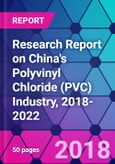China is the world's largest PVC producer and consumer. At the end of 2017, China's PVC production capacity exceeded 20 million tons/year. In 2017, the production volume of PVC in China was approximately 17.9 million tons, an increase of 7.2% year-on-year.
In 2017, there were more than 60 PVC producers in China, 20 of which had an annual capacity of 400,000 tons or more. Most of them are located in Inner Mongolia, Xinjiang, Shandong and Qinghai. The two largest PVC producers are situated in Xinjiang, namely, Xinjiang Zhongtai Chemical Co., Ltd. (with an annual production capacity of 2.2 million tons) and Xinjiang Tianye Co., Ltd. (with an annual production capacity of 1.2 million tons). In China, PVC is produced in the calcium carbide method or in the ethylene method. The calcium carbide method accounts for over 80% of China's PVC production capacity. PVC produced in the calcium carbide method is mainly used in the production of low-end pipes because it contains a large amount of vinyl chloride residues. While PVC made from ethylene, containing little vinyl chloride residue, can be used to produce refined high-end PVC products that cannot be produced with PVC made from calcium carbide. PVC made from ethylene and PVC made from calcium carbide can hardly replace each other.
Economically developed regions such as Guangdong and South China are the major consumers of PVC in China. Guangdong accounts for over 20% of the total PVC consumption in China; Fujian, Shanghai, Jiangsu and Zhejiang in East China account for more than 30% of the national total.
The downstream applications of China's PVC mainly include construction materials, pipes, etc. Among building materials, sections, doors and windows account for about 30% PVC consumption; pipes account for about 30%; and film accounts for nearly 10%.
According to market research, China's PVC industry is still expanding its production capacity in 2018-2019. It is expected that by the end of 2020, China's annual PVC production capacity will exceed 27 million tons.
China's PVC industry is playing an increasingly important role in the global PVC industry. China has grown from a net PVC importer into a net PVC exporter. Especially since 2003 when China took anti-dumping actions against PVC imports, PVC made from calcium carbide has been developing rapidly in China. In 2006, China surpassed the U.S. in both the capacity and volume of PVC production, becoming the largest PVC producer in the world. As the Chinese economy develops and the urbanization rate increases, the demand for PVC will continue to expand in China from 2018 to 2022.
Topics Covered:
- Supply of and demand for PVC in China
- Major PVC producers in China
- Market price of PVC in China
- Competition on China's PVC market
- Import of PVC in China
- Major driving forces and market opportunities for China's PVC industry
- Prospect of China's PVC industry from 2018 to 2022
Table of Contents
Companies Mentioned
- Hangjin Technology Co. Ltd.
- Hongda Xingye Co. Ltd.
- Hubei Yihua Chemical Industry Co. Ltd.
- Inner Mongolia Junzheng Energy & Chemical Group Co. Ltd.
- Ningxia Younglight Chemicals Co. Ltd.
- Shanghai Chlor-Alkali Chemical Co. Ltd.
- Sichuan Jinlu Group Co. Ltd.
- Xinjiang Tianye Co. Ltd.
- Xinjiang Zhongtai Chemical Co. Ltd.
- Yibin Tianyuan Group Co. Ltd.
Methodology
Background research defines the range of products and industries, which proposes the key points of the research. Proper classification will help clients understand the industry and products in the report.
Secondhand material research is a necessary way to push the project into fast progress. The analyst always chooses the data source carefully. Most secondhand data they quote is sourced from an authority in a specific industry or public data source from governments, industrial associations, etc. For some new or niche fields, they also "double-check" data sources and logics before they show them to clients.
Primary research is the key to solve questions, which largely influence the research outputs. The analyst may use methods like mathematics, logical reasoning, scenario thinking, to confirm key data and make the data credible.
The data model is an important analysis method. Calculating through data models with different factors weights can guarantee the outputs objective.
The analyst optimizes the following methods and steps in executing research projects and also forms many special information gathering and processing methods.
1. Analyze the life cycle of the industry to understand the development phase and space.
2. Grasp the key indexes evaluating the market to position clients in the market and formulate development plans
3. Economic, political, social and cultural factors
4. Competitors like a mirror that reflects the overall market and also market differences.
5. Inside and outside the industry, upstream and downstream of the industry chain, show inner competitions
6. Proper estimation of the future is good guidance for strategic planning.

LOADING...








